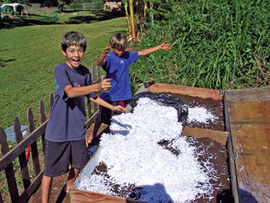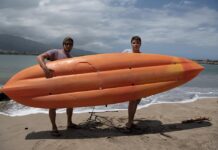Rita Goldman
 In 1899, Dr. Maria Montessori began observing institutionalized youngsters who were considered “incapable of learning”—and discovered that in fact they were starved for mental stimulation. When their environment responded to their mental, physical, and emotional needs at each stage of their development, “learning,” wrote Dr. Montessori, “comes easily and is a joy.”
In 1899, Dr. Maria Montessori began observing institutionalized youngsters who were considered “incapable of learning”—and discovered that in fact they were starved for mental stimulation. When their environment responded to their mental, physical, and emotional needs at each stage of their development, “learning,” wrote Dr. Montessori, “comes easily and is a joy.”
Her results astounded the scientific community. Under Montessori’s tutelage, these “learning disabled” children outperformed many “normal” youngsters in conventional schools.
The importance of a prepared learning environment became a tenet of Montessori education. Today the directors, staff, parents, and students of Montessori of Maui, Inc., are making environmental history of their own, creating a sustainable “green” campus that will bring together cutting-edge technology, Montessori principles, and ancient Hawaiian wisdom.
Established in 1978, MOMI spent 14 years being shuffled from one temporary location to another, before finally obtaining a nine-acre site on Baldwin Avenue, just up the hill from Hui No‘eau Visual Arts Center. The little school that started in a Quonset hut in Ha‘iku was on its way to becoming the first Montessori-designed campus in the state, its classrooms clustered amid enormous old banyan and monkeypod trees.
“Maria Montessori believed that nature is the best teacher, and that children need to learn to be good stewards of the earth,” says Cynthia Burns, MOMI’s head of school. “We took it further. In 1996, we started planning an outdoor learning environment, a living classroom. A $25,000 grant from Oasis Group enabled us to build a Hawaiian-style irrigation system and fund a master gardener to work with the children.
“Then we asked, why stop at the garden?”
Plans had long called for a second phase of construction. Over the years, Montessori of Maui had expanded in every conceivable direction: adding a toddler facility to its preschool, a middle school beyond its upper elementary classes. By 2005, MOMI was serving 197 students, ages 18 months to 15 years—and the waiting list surpassed enrollment.
Although “going green” would add time and expense to campus expansion, the decision won the support of the MOMI community. Staff members traveled to the Mainland for workshops on how to comply with the rigorous requirements for LEED certification. (LEED stands for Leadership in Energy and Environmental Design, a rating system developed by the U.S. Green Building Council.) When the Henry and Dorothy Castle Memorial Fund presented Burns with a $1,000 Leadership Development Award, the head of school funneled the money into paying Heather Peterson, a naturalist with a master’s degree in environmental management, to serve as the school’s sustainability coordinator.
And in 2003, Stephen Meder, of the University of Hawai‘i’s School of Architecture, donated his time to help develop guidelines for MOMI’s sustainable campus. More than two-dozen community volunteers—including architects, builders, engineers, and representatives from Maui Electric, Aloha Recycling, Maui Community College, and the county’s Water and Public Works Departments—joined Professor Meder and MOMI staff and directors on the Makawao campus for a one-day design charrette, an intensive brainstorming session that laid the foundation for a remarkably comprehensive manual on sustainability and how it can be integrated with the curriculum.
The little school on the slopes of Haleakala has found itself in the vanguard of a global movement. The National Association of Independent Schools made sustainability a major theme of its 2005 conference in San Diego. “NAIS is aligning itself with the United Nations’ Decade of Education for Sustainable Development (2005–2014),” the conference program states, citing UNESCO’s focus on teaching the next generation “to make decisions that consider the long-term future of the economy, ecology and equity of all communities.” Attending the conference, Cynthia Burns found herself sharing MOMI’s efforts with fellow participants hungry for information on how to put sustainability theory into practice.
What sets Montessori of Maui apart is the degree to which sustainability is being incorporated into the curriculum, right from the Guidelines’ get-go. Directives on reducing site disturbance suggest opportunities for children to work with engineers in learning and charting the process of construction. Standards for energy use per square foot per building will introduce students to the laws of thermodynamics. Measures to reduce light pollution can lead to exploration of the night sky.
One of the most important lessons for youngsters at Montessori is that technology can serve ancient wisdom. For more than a thousand years, Hawai‘i’s indigenous people thrived in this, the most isolated place on earth, precisely because they were masters of sustainability. The interconnectedness of all living things, the knowledge that man is a part of nature and damages it at his peril, were concepts inherent to Hawaiian thought and practice—and fit perfectly with Montessori.
Cynthia Burns explains: “Maria Montessori stressed that academics are the tools for acquiring education; they are not education in themselves. Dr. Montessori defined the goal of education as ‘the development of a complete human being who is oriented to the environment, and adapted to his or her time, place, and culture,’
“We’re not preaching doctrine here. Our goal is to help children develop the academic tools and quality of mind to engage in a dialogue with the dilemmas of their generation. Our kids will need to be strategic and global thinkers with a keen sense of social responsibility. They are the kind of citizens our planet needs.”
Montessori of Maui’s 96-page Guidelines of Sustainability takes into consideration every aspect of the school’s design, construction and operation. Here’s a small sample:
• Work with existing topography to minimize excavation and earthmoving.
• Design landscape to reduce runoff velocity and protect unstable zones.
• Use recycled gray water for wastewater processes. Use composting toilets where possible.
• Consider multiple uses of buildings rather than simply more buildings—stagger usage schedules.
For more information, contact Montessori School of Maui, 2933 Baldwin Avenue, Makawao, Hawai‘i 96768; (808) 573-0374.





